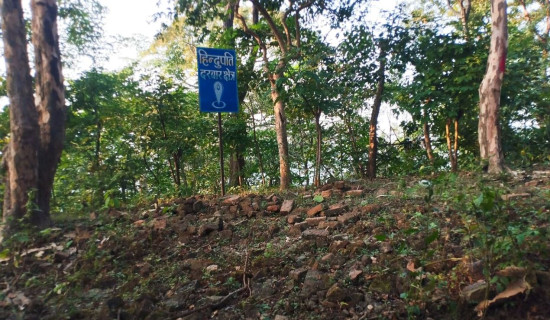- Friday, 28 November 2025
Evolution Of Vihar And Vajrayana
The indigenous groups abandoned by the surrounding high peak mountains crossed the borderline and stayed in the natural valley. They were kind and interested in rituals and adopting religion. More interest was seen in forming a community numerically from village to village. Mostly, they liked to bow down towards Buddhist aspects and principles. So, they were affected by southern culture and trends. They became followers of Buddhist principles. After some decades, they came down into the core valley areas. Those habitats had sentiments of holy Buddhist thoughts. But their living culture and habits were the same as previously in the peak mountains.
With the passing of time, they learned about different community settlements. They learned to lay out the community places. They constructed a yard that was in the middle of the surrounding houses. This yard was mostly square or rectangular in shape. It means the surrounding areas were built with community houses and the central place was open and designed. This open place was given the name of a yard, where they vowed their keen interest to establish some archaeological temples and stupas. In such a living style and methodology, they were known as the Vajra community, and their creation was established as a Vihar.
Origin of Bihar
Again, the definition of a Vihar has some historical phenomena. In the 6th century B.C., Lord Buddha established many Viharas in the northern part of India. In those periods, a Vihar was used as a place for monks and nuns to stay and for sermons. Here, it would be fruitful to classify that the word ‘Vihar’ refers to staying, walking through, or moving on. So, the word ‘Vihar’ is derived from the word ‘Viharati,’ which means to rest, move, or walk across bounded places. In the holy Buddhist book Tipitaka Sutta, Lord Buddha rested within the Jetvan Vihar, which was built by the tycoon Anath Pindak in the city of Shrawasti.
Nowadays, it can be seen in the northern part of India, known as Vihar Pradesh. Even this Vihar Pradesh was named based on the presence of many Buddhists Viharas in the same region. In Nepal, Vihar can be described both in terms of clan and topographical situation. According to the principles of Buddhism, there are generally three types of Viharas. The Vihar followed Buddhist concepts and practices. There are Hinayana, Pratyakyana and Mahayana Viharas who practice Buddhist principles to achieve Moksha.
Even in Yana, it refers to the practicing mode or way of practice. Buddhist theories had a widely pragmatic approach with different visions, but the goal is only one. Let’s talk briefly about Hinayana. In ancient times, Hinayana was famous for Buddhist principal practices. There were only two followers: monks and nuns. Monk denotes male followers, and nun denotes female followers. The monks and nuns chanted the ‘Tri Petak.’ The Tri Pitaka mentioned the main Buddhist principles and theories. Both followers stayed in the Vihar. This Vihar was called the ‘Theravada’ Vihar. Another name for them was ‘Shrawakyana,’ pronounced by ‘Bhante’ for monk and ‘Guruma’ for nun.
Another Yana was Pratyakyana. The monk who was quietly venerable and superior and was worthy of worship. He himself was known as a self-Buddha. He wouldn’t go to preach, and he didn’t have any followers. Neither did he like to pursue sermons nor reside within a Vihar. He liked to be free—no up, down, right, or left activities. His ambition was only meditation and to reach Moksha. So, he was well known as a Pratyek Buddha. It was said that such types of Buddhas were incarnated while Buddha was not present on Earth. It was said that most often, after thousands of centuries, this condition would prevail on Earth.
Mahayana is the last Yana but not the least. This Yana was very pragmatic as well as behavioural in nature. Many steps were practiced at different levels during the process. I am very interested to bow down and explain about the Mahayana stream in the present context. I am writing here some Mahayana ventures in connection with Buddhist principles. I think this theory is the most advanced Buddhist principle.
‘Mahayana’ is a symbol of a great way to go. ‘Maha’ means great and ‘Yana’ means to go. When Buddha preached his first sermon at Mrigadavan to five venerable monks that was named the first wheel of Shrawakyana, two months after Buddha’s enlightenment. After 13 years of Buddha’s enlightenment, according to Maitryanath’s Astasahasrika Tika Granth, Buddha preached to venerable monks, special followers, deities, and bodhisattvas of Prajnaparamitopadesh Shastra-Abhisamayalankarbitti at Gridhakut Mountain of Rajgir. This sermon was about the void philosophy of the entire universe.
Mahayana branch
This was named the ‘Mahayana.’ So, we can understand that the principle of Mahayana was the knowledge of the void philosophy of the entire universe. Even Mahayana became the key theory of Buddha’s principles. Some decades later, it branched into other principles like Tibetan Mahayana and Southern Vajrayana. Buddhist teaching principles were the same in Mahayana and Vajrayana, but chanting, slogans, and practicing methods were slightly different. At present, Mahayana is practiced in the northern part of Nepal alongside the Tibetan region.
While Buddha had been enlightened and ahead of 16 years, Tathagat Buddha had given a sermon to high-level monks, special deities, and bodhisattvas focusing on Tantra, Mantra, and Yog. It was said that in this sermon, Buddha had formulated the principles of ‘Voidness, Nonproductive, Philosophy of Scientific, Impermanence of All Religion, and Arya Sandhi Nirmochan.’ Recalling to memory, this sermon had been addressed at the ‘Dhanyakatak Sri Parvat of Maharashtra.’ This sermon had been called the ‘Mantra Naya or the Vajrayana.’ With reference to the above statement, the Tibetan source had shown up. So, Vajrayana was raised from the Dhanyakatak Sri Parvat during the time of the venerable Lord Buddha era. It was said that with the practices of Tantra, Mantra, Yoga, and Anuttara Yoga, a human can achieve the bodhisattva within his lifetime. It was named the Vajrayana.
(The author is an engineer at the Kathmandu Metropolitan City.)















